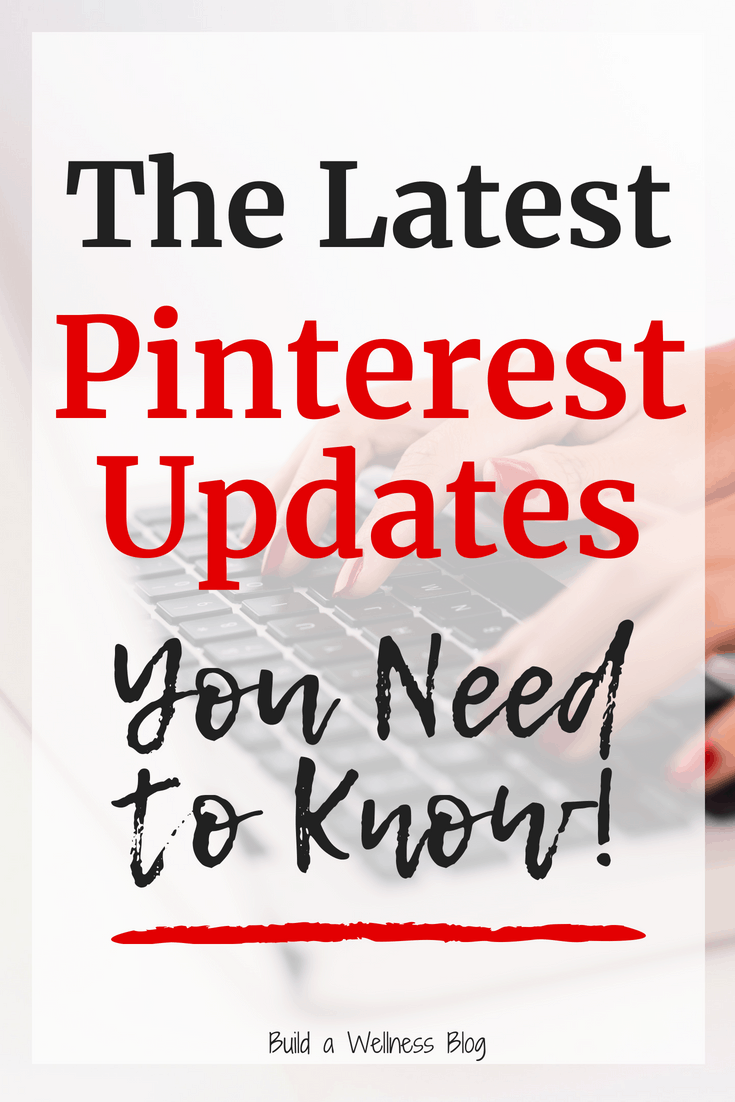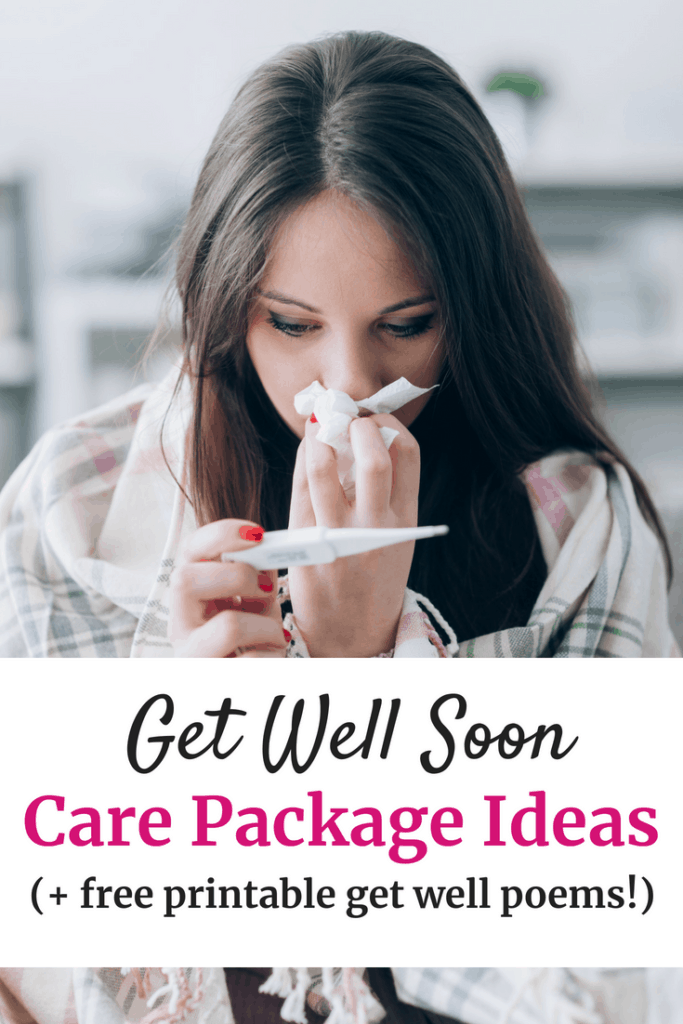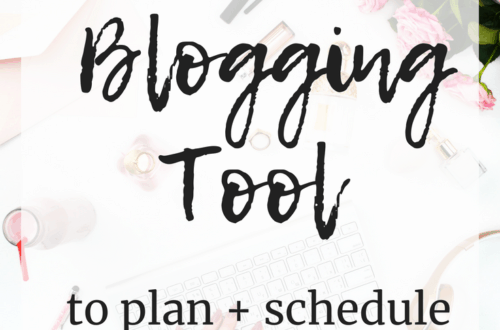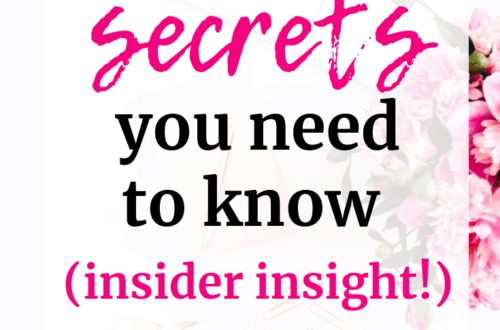
The 2018 Pinterest Updates You Need to Know About!
Pinterest is arguably one of the best platforms for bloggers – especially those in the health and wellness field – but it is also one of the most frustrating. Frequent Pinterest updates can make it hard for bloggers to determine the best strategy to grow their following and traffic.
If you’re worried about all the changes to Pinterest, take a deep breath – the basics are still the same. However, there are a few key updates that you should be aware of, and some tips to maximize your growth in light of those updates.
But First – Why You Need to Be on Pinterest:
Earlier today, a fellow blogger told me she was struggling to get traffic to her blog using Instagram. This didn’t surprise me – while Instagram is amazing for stunning visuals and connecting with people, it’s notoriously not a great traffic driver (for most people).
Pinterest, on the other hand, can drive tremendous traffic. Pinterest isn’t social media so much as a large visual search engine. Think of it like Google, but with photo instead of text results – and with more than 2 billion monthly searches taking place each month. The visual nature makes this perfect for posts like recipes and workouts. But it also can work quite well for other wellness-focused posts too.
By creating visually appealing graphics for your pins, and properly keywording your pin descriptions, you’ll appear in search results on Pinterest. The better you get at this and the more content you have floating in the Pinterest-sphere, the more traffic you’ll drive to your site.
2018 Pinterest Updates:
1. Use Hashtags
So technically this was a fall 2017 update, but it seems to be one a lot of people are still unsure about. For years, Pinterest gave a firm no when people asked about using hashtags; hashtags had no place in pins. Then, in late 2017, they flip flopped their stance – they came out and encouraged people to start using them!
What’s really cool (in my opinion) is the way that hashtag searches work. Searching by hashtag will show the most recent results first – i.e. a chronological feed – rather than the smart feed that occurs with normal searches.
For example, let’s say you searched for “healthy dessert” (without the hashtag). Pinterest will bring up pins based on their smart feed, which is determined via a whole host of factors (like account popularity, pin popularity, pin relevance, etc). If you search “#healthydessert”, Pinterest will display the most recent pins first.
This is why you want to use hashtags – it will help to maximize your exposure under this separate type of search.
Here are a few quick tips when it comes to Pinterest hashtags:
- You can and should start using hashtags. Do not use hashtags for your entire description though! Write your description like you normally would using several keyword phrases, and then add relevant hashtags on at the end.
- Use a mixture of timely (i.e. #christams, #fall) and evergreen (i.e. #healthy, #workout) hashtags.
- Pinterest says to use no more than 20 hashtags – I recommend 5 or so at the end of your pin description.
For a more in-depth dive, be sure to check out this post on Pinterest hashtags.
2. Ignore the “first 5” rule.
In 2018, Pinterest updated their official best practice guidelines to say that your first 5 pins of the day would be given the most relevance. Less than two months later, that info had disappeared. They confirmed to several bloggers at an exclusive Pinterest event that the “first 5” was no longer being prioritized.
However, it is important to pin at times when your audience is likely to be on Pinterest and most engaged. For most of us, that’s likely in the evenings. And it’s also important to show up and be present in the platform daily (or as close to daily as you can get).
3. Link multiple pins to the same place.
While this has always been a good idea (and something I’ve taught in my Pinterest course), it became official Pinterest guidance relatively recently. By creating several pin images that can link to the same blog post, and slightly different descriptions for each, you’ll maximize chances for success. Different images can appeal to different people. And different text descriptions lead to more chances of being found in search.
Here’s a real example from a recent sponsored post I did over on Snacking in Sneakers. The post was about care packages when you’re sick.

Both images tell what the post is about, but one is targeted in a more feminine, caring light, while the other is showcasing the funny poem.
I also created somewhat different descriptions for each. The first image had this description:
These care package ideas for a sick friend are the perfect way to cheer up your pals! Find fun ideas to make a DIY get well soon package along with free printable get well poems. #carepackage #getwellsoon #getwell #poem #printable
The second image had this description:
Want to cheer up a sick training buddy? Download these free printable get well soon poems for runners and triathletes – plus find a ton of great get well soon care package ideas! Great for running motivation to help your friends get excited about training when they feel better. #carepackage #getwellsoon #getwell #running #sickday
I’ll pin that first image & description and set in on an interval schedule in Tailwind (referral link – you can grab a free month!), and then I’ll start pushing out the second image. You can also test out doing both images simultaneously.
4. Familiarize yourself with the new Pinterest profile.
A lot of people got this update months ago, but I literally just received the “new” profile layout within the last few weeks! Regardless, here are a few things to know about the new Profile layout:
Your monthly viewers are the number of people each month that are exposed to your pins. It does not mean that’s how many people clicked on your pins, or that’s how many people saved your pins. (For that data, go to analytics). It does give you one glimpse into how effective your Pinterest strategy is, though, as the more viewers there are seeing your pins, the more likely you are to hopefully achieve those saves and click throughs.
The “activity” tab shows what people are pinning from your domain. One thing to test out is repining the content from this tab, and seeing if it helps increase your exposure.
You can still find the number of followers you have by clicking the “followers” tab. It will display the total number at the top.
5. Focus on high quality, relevant personal boards – and some good group boards.
Years ago, if you got on a good group board for Pinterest, you could get your content seen by a lot of people. Pinterest recognized that glitch in the matrix, and I think it’s one of the reasons there was the switch to the smart feed – it helped decrease the amount of content shown from any one source at any one time so people were less able to take advantage of that.
In 2018, Pinterest has said that group boards will continue to be deprioritized a bit. It does not mean that group boards are dead. If you are participating in good group boards – with a moderate, engaged following and a small-ish number of contributors – those are amazing.
But if you’re aimlessly pinning to group boards that have a million contributors and a non-engaged following, don’t count on them for driving a ton of traffic back to your site. You can use Tailwind to see the effectiveness of your group boards – I recommend cutting those that aren’t serving their purpose.
You’ll also want to focus on creating more niche specific, relevant personal boards – and pin to these boards first for new pins.
For example, let’s say you are a fitness blogger and you have a board for “workouts”. Can you niche down further and create multiple boards – think at home workouts, gym workouts, full body workouts, etc. These will help Pinterest understand the type of content that you’re pinning better, and may help your pins get seen in more search results.
6. No More Super Long Pins
These were a big trend in Pinterest for the last few years – super long pins that would stand out in the feed. However, with the new Pinterest updates, they no longer recommend very long pins. In fact, they will be truncated in certain mobile applications (and possibly desktop as well).
Instead, stick with the 2:3 aspect ratio of around 600×900 or 735×1100 – either works fine. You can go slightly longer than that, but I wouldn’t recommend too much longer.
7. Keep an eye on the “Tried It” Function.
Here is what no one is talking about but I am convinced this will be a key metric in Pinterest’s search results in the upcoming year, if it’s not already.
When you click on pins, there is a space to leave comments and photos if you’ve “tried it” – i.e. made the recipe or did the workout. Here is an example from one of my recipe pins – you can see two people left photos from trying the recipe, and there’s the button to click on for other people to do so as well:
There is no official guidance from Pinterest on the role of this specific feature as far as influencing search presence but think about it – if Pinterest notices that lots of people are reporting that they tried your pin, it’s demonstrating that it’s engaging content. This is what Pinterest wants to see and they have said engagement matters.
How can you use this to your advantage? Just like you might ask your readers to rate a recipe, you can also include a call to action asking your readers to use the “tried it” function on Pinterest.
You can also help out your fellow blogger pals – if you make their recipes, throw them a little goodwill and snap a quick photo to upload in this feature.
Share with me: Are you a fan of Pinterest for driving blog traffic? What questions do you have about Pinterest?







